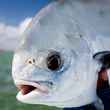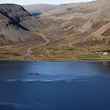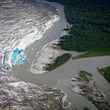Despite the current trend of positive news regarding salmon habitat in the Pacific Northwest, which includes dam removal and associated habitat restoration efforts, a recent study suggests that global warming will pose a very significant threat to salmon populations that migrate through the waters of that region. According to the study, the continuing trend of rising global temperatures will lead to an rise in water temperatures that will render an increasing amount of habitat dangerous to migrating salmon.
As salmon migrate, they must avoid thermal pockets in streams and rivers where the water temperature is outside their range of tolerance. For most salmon, this is around 70 degrees. Above that threshold, conditions become dangerous and potentially fatal. The results of the study, led by University of Washington professor Nathan Manuta, indicate that -- in the next decade alone -- water temperatures in several Pacific NW waters will rise 1-2 degrees. While this rise may seem modest, the study indicates that this increase in temperature will push a considerable amount of habitat currently in the upper reaches of salmon tolerance into a zone of potentially fatal conditions. This is especially true for waters of the lower Columbia and Snake rivers.
In the longer term, the forecast is more grave. By 2080, Mantua's research suggests that temperatures in northwestern waters could rise as much as 3.6 to 9 degrees fahrenheit. In addition to creating significantly more "danger zones" via these more dramatic temperature increases, the number of weeks during which these dangerous conditions exist is expected to double.

The increasing stream temperatures are not due only to the global effects of increasing greenhouse gas emissions. Other human impacts on freshwater habitats, such as dam building, redirection of streamflow for agricultural irrigation and the clearing of stream-side forests are also major contributing factors to the dangerous thermal changes occurring in these waters.
[via Climate Watch Magazine]































Comments